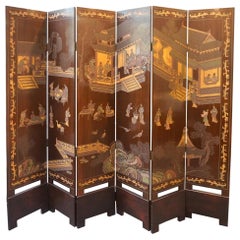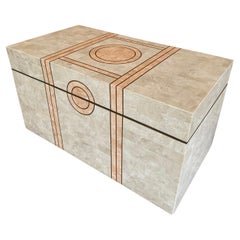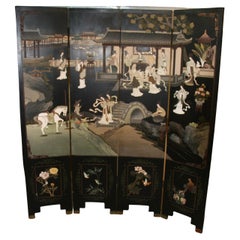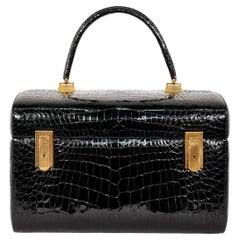Brass Home Accents
to
131
563
423
845
163
13
193
71
69
46
34
13
10
9
8
8
5
5
4
3
3
2
1
1
14
147
684
176
144
250
114
9
12
31
31
17
48
33
41
24
5
2,528
2,391
1,021
718
694
602
241
176
166
117
1,021
926
948
141
63
12
10
10
Material: Brass
Late 19th Century Small Size Globe Edited by Philips Terrestrial London
Located in Casteren, Noord-Brabant
A lovely small size antique French globe. With a wooden base, the globe itself is made of carton with paper. The map is published by Philips Terre...
Category
1890s French Belle Époque Antique Brass Home Accents
Materials
Brass
Six-Panel Double Sided Coromandel Asian Screen on Stand
Located in Germantown, MD
Six-panel double sided Coromandel Asian Screen on stand. Each panel seats in a removable custom wood stand / shoe. Brownish gold color on one side and nature on the other. The subje...
Category
Mid-20th Century Hong Kong Chinese Export Brass Home Accents
Materials
Brass
Maitland Smith Coral Trunk with Brass Trim
Located in Round Top, TX
Coral and pink coral set in an Art Deco influenced geometrically oriented inlaid design. The brass trim is patinated naturally from age, and the interior is wood-lined for storage of...
Category
Late 20th Century Philippine Art Deco Brass Home Accents
Materials
Coral, Pink Coral, Brass
Chinese Coromandel Four Panel Screen Room Devider Landscape Scene
Located in Douglas Manor, NY
1707 Chinese coromandel four panel screen featuring figures,birds ,flowers engaged in leasure activities in a garden setting
Folded dimensions W 16.5" 72" H 3.5"D
Category
1950s Vintage Brass Home Accents
Materials
Brass
$2,560 Sale Price
20% Off
Italian Genuine Black Crocodile Train Beauty & Jewelry Case by Revlon, 1960s
By Revlon
Located in Miami, FL
Embrace elegance and style with this extremely rare, genuine black crocodile train case by Revlon. The mint condition beauty and jewelry case fea...
Category
20th Century Italian Art Deco Brass Home Accents
Materials
Brass
Chinese Export Lacquered Six Panel Coromandel Landscape Screen
Located in Rio Vista, CA
Beautifully weathered patina Chinese export lacquered coromandel screen with six double sided panels. The screen features a mountain landscape on one si...
Category
20th Century Chinese Chinese Export Brass Home Accents
Materials
Brass
17th Century French Leather Coffer with Nailhead Detail
Located in Houston, TX
17th century French leather coffer, chest or trunk with nailhead detail from burgundy on newer wooden base.
Category
17th Century French Renaissance Antique Brass Home Accents
Materials
Brass
Louis Vuitton Trunk, 1940s France
Located in Los Angeles, CA
Custom vintage Louis Vuitton trunk from the 1940s. Stunning display piece with irregular shape/opening. Perfect for storing papers, books o...
Category
1940s French Mid-Century Modern Vintage Brass Home Accents
Materials
Brass
Skulls Bookend Set of 2
Located in Paris, FR
Skulls Set of 2 bookend with polished nickel finish
structure. Skulls in solid brass in bronzed finish.
Dimension of each bookend: L19xD12,5xH20,5cm.
Category
21st Century and Contemporary Indian Brass Home Accents
Materials
Brass, Nickel
$894 / set
Ben Seibel Bookends Mid Century 1960s
Located in New York, NY
Mid Century 1960s Brass Bookend. Ben Seibel designed for Raymor. Still retains original marking sticker and felt bottom. Modern sculptural des...
Category
Mid-20th Century Mid-Century Modern Brass Home Accents
Materials
Brass
Antique Large Leather Suitcase with Original Travel Stickers c.1920
Located in San Francisco, CA
ABOUT
Antique large leather suitcase with fabric interior, interior pouch, leather straps, brass latches and original key and locks. Original travel tag, "Italian Line, Cabin Class"...
Category
Early 20th Century Industrial Brass Home Accents
Materials
Brass
19th C. Victorian Original Double Handled Initialed Leather Portmanteau Suitcase
Located in Vancouver, British Columbia
Rare large leather double handled Victorian portmanteau. Beautifully handcrafted with attention to detail. In original unrestored condition. Initial plaque may be screwed in from wit...
Category
1860s English Victorian Antique Brass Home Accents
Materials
Brass
$2,925 Sale Price
25% Off
Louis Vuitton, Steamer Trunk, Monogram Canvas, Leather, Special Order
Located in Manhasset, NY
Louis Vuitton, Steamer Trunk, Monogram Canvas, Leather, Special Order Style m12031 Custom with a wait time of up to two years.
We are pleased to offer one of two large and impressi...
Category
1990s French Modern Brass Home Accents
Materials
Brass
Metamorphic Library Steps
Located in Sturminster Marshall, Dorset
A George III design, mahogany four-step metamorphic library coffee table, with decorative gilt incised leather top and leathered steps opening to f...
Category
21st Century and Contemporary English George III Brass Home Accents
Materials
Brass
$6,070 / item
1920's Louis Vuitton Trunk in Monogram, 100 cm Louis Vuitton Steamer Trunk
Located in Saint-Ouen, FR
This superb Louis Vuitton steamer trunk features stenciled monogram canvas, deep chocolate color leather trim, LV stamped solid brass locks and studs as well as solid brass side hand...
Category
1920s French Vintage Brass Home Accents
Materials
Brass
Louis Vuitton, Large Steamer Trunk, Monogram Canvas, Leather, Special Order
Located in Manhasset, NY
Louis Vuitton, Large Steamer Trunk or Wardrobe Case, Monogram Canvas, Leather, Special Order Model number m12010 with a wait time of two years.
We are pleased to offer one of two special order large and impressive Louis Vuitton steamer trunks...
Category
20th Century French Modern Brass Home Accents
Materials
Brass
Mid-20th C. Imperial East Coromandel Etched and Painted Six-Fold Floor Screen
Located in Germantown, MD
A Mid-20th Century Chinese Coromandel Etched and Painted Six-Fold Floor Screen screen or room divider. Exclusively made by Imperial East New York
Measure...
Category
20th Century American Modern Brass Home Accents
Materials
Brass
Copper and Brass Umbrella Stand by Vereinigte Werkstätten München, circa 1955
Located in Landau an der Isar, Bayern
Delightful handcrafted German Mid-Century modern umbrella stand or holder by the Vereinigte Werkstätten (Atelier) München, circa 1955. Handmade in patinated copper with cast brass tr...
Category
Mid-20th Century German Mid-Century Modern Brass Home Accents
Materials
Brass, Copper
S3 Screen
Located in Milan, IT
This superb screen was made entirely by master craftsmen using artisanal techniques. Its geometric Silhouette, inspired by Art Deco, will enrich any decor. The three panels rest on a...
Category
2010s Italian Brass Home Accents
Materials
Brass
$12,144 / item
18th Century Spanish Leather and Brass Nailhead Domed Trunk with Original Key
Located in Dallas, TX
This handsome Spanish trunk was crafted circa 1780 and features a domed wooden frame clad in hand-stitched leather, richly decorated with large and small brass nailheads in a rhythmi...
Category
Late 18th Century Spanish Gothic Antique Brass Home Accents
Materials
Brass
Brass Bird Cage - 19th Century
Located in Brussels, Brussels
lovely 19th century brass birdcage
Beautiful small, very refined model with two brass eating containers which are very well sculpted
The uprights are twisted which is unusual and ve...
Category
19th Century British Victorian Antique Brass Home Accents
Materials
Brass
Extra Large Louis Vuitton Steamer Trunk, High Vuitton Trunk in Checkers Canvas
Located in Saint-Ouen, FR
This superb Louis Vuitton steamer trunk features the very sought after checkers canvas, all leather chocolate color trim, LV stamped solid brass locks and studs as well as solid bras...
Category
Late 19th Century French Antique Brass Home Accents
Materials
Brass
Vintage Painted Four-Panel Screen with Canal Village Scene
Located in Yonkers, NY
Lyrical and dreamlike, this vintage Chinese four-panel screen invites the viewer into a world suspended in time. Painted in soft washes of sepia, stone, and shadowed jade, the scene ...
Category
Late 20th Century Chinese Brass Home Accents
Materials
Brass
Authentic Antique Brass Ship’s Ladder from the Late 19th Century
Located in Hamburg, DE
Step into the past with our authentic antique brass ship’s ladder dating back to the late 19th century. Originally crafted for ship cabins, this meticulous...
Category
Late 19th Century British Belle Époque Antique Brass Home Accents
Materials
Brass
Dome Top Trunk W/ Embossed Metal Star Design
Located in San Francisco, CA
C. 20th Century
Dome Top Trunk w/ Embossed Metal Star Design on stand w/ Casters.
Original Papered Shelf Insert & Brass Banding.
Category
20th Century Brass Home Accents
Materials
Metal, Brass
Louis Vuitton Courrier Trunk in Damier Canvas 90 cm, Vuitton Steamer Trunk
Located in Saint-Ouen, FR
This Vuitton trunk is one of the rarer Louis Vuitton trunks to be offered currently. Indeed , it features the world famous and sought after damier (checkerboard) canvas. Dating to 1889, it is a wonderful example of such luxury trunks...
Category
Late 19th Century French Antique Brass Home Accents
Materials
Brass
1920's Louis Vuitton Trunk in Monogram, Louis Vuitton Steamer Trunk 100 cm
Located in Saint-Ouen, FR
This superb Louis Vuitton steamer trunk features stenciled monogram canvas, honey color lozine trim, LV stamped solid brass locks and studs as well as leather side handles and brass ...
Category
1920s French Vintage Brass Home Accents
Materials
Brass
Vintage Pair Brass Bookends Horse Head Statues
Located in Poperinge, BE
Vintage pair of bookends, made of yellow copper or brass, the bookends have the shape of a horse's head, second half of the 20th century.
These objects are made of brass, they have ...
Category
1970s Vintage Brass Home Accents
Materials
Brass
Poilerat Art Deco Iron and Brass Curved Panel Screen
Located in Houston, TX
French Art Deco Gilbert Poillerat screen. A hand wrought iron two part screen with gracious sinuous curves, brass accent detail and verdigris coloring.
Overall dimensions:
Left p...
Category
Early 20th Century French Art Deco Brass Home Accents
Materials
Brass, Wrought Iron
Vintage Roman Column 6 Panel Architectural Incised Privacy Screen Room Divider
Located in Wayne, NJ
Large decorative 6 Panel Architectural privacy screen room divider. Will go well with style decor . From Traditional to Modern. This is a heavy in weight piece. Many details are inc...
Category
1970s Unknown Modern Vintage Brass Home Accents
Materials
Brass
$5,000 Sale Price
28% Off
1920's Louis Vuitton Steamer Trunk in Stenciled Monogram, 120 cm Vuitton Trunk
Located in Saint-Ouen, FR
This superb Louis Vuitton cabin trunk is spectacular and very rare.Indeed, its dimensions are huge for a cabin trunk since it reaches 122 cm wide and 41 cm tall. These dimensions are...
Category
1920s French Vintage Brass Home Accents
Materials
Brass
Vintage Regency Gracie Style Upholstered Three Panel Screen
Located in West Palm Beach, FL
Add a touch of timeless elegance to your space with this Vintage Regency Gracie Style Upholstered Three Panel Screen. Featuring a vibrant botanical and bird motif set against a strik...
Category
21st Century and Contemporary American Chinoiserie Brass Home Accents
Materials
Brass
Vintage 20th Century Louis Vuitton Trunk In Monogram Canvas, France c.1926
Located in Royal Tunbridge Wells, Kent
An early 20th Century monogram trunk by Louis Vuitton. This trunk was the must have item of any elite traveller. Covered in the world famous LV Monogram canvas, it oozes style and elegance. Inside, a full length tray, a hat basket and a split tray in the classic ercu canvas. A fantastic conversation piece, great size for a coffee table or just as a standalone item suitable for any interior.
This particular example dates to around 1926 and is a great example of Louis Vuitton’s Monogram trunks...
Category
20th Century French Other Brass Home Accents
Materials
Brass
Vintage Louis Vuitton Monogram Overnight Case Trunk Luggage, circa 1980
Located in Krefeld, DE
Louis Vuitton Vintage Monogram Canvas Travel Trunk. Brown monogram canvas, leather base and top. The key is missing and the trunk comes with patina :-
Nice for decoration or trave...
Category
20th Century German Mid-Century Modern Brass Home Accents
Materials
Brass
Early 20th Century Louis Vuitton Monogram Twelve Shoe Case
Located in Chicago, IL
This Louis Vuitton shoe case, dating from 1910 to 1930, exemplifies the brand's innovative craftsmanship. It features hand-painted canvas monog...
Category
Early 20th Century French Art Deco Brass Home Accents
Materials
Brass
19th Century Austrian Large Antique Polished Brass Birdcage by Josef Denk
By Josef Denk
Located in West Palm Beach, FL
A large antique Austrian birdcage made of handcrafted metal, the vertical lattice struts are made of polished brass, designed by Josef Denk in good condition. The round decorative birdcage...
Category
Late 19th Century Austrian Art Deco Antique Brass Home Accents
Materials
Metal, Brass
$11,920 Sale Price
20% Off
1920's Moynat Trunk In Orange Canvas, 75 cm Moynat Steamer Trunk, Moynat Trunk
Located in Saint-Ouen, FR
This little Moynat steamer trunk features very nice and sought after orange canvas as well as solid brass corners, 1 brass lock and 2 clasps , two large leather side handles and one ...
Category
1910s French Vintage Brass Home Accents
Materials
Brass
Louis Vuitton Trunk, Louis Vuitton Suitcase, Vuitton Steamer Trunk, Alzer 80
Located in Saint-Ouen, FR
This piece of luggage is a magnificent Louis Vuitton Alzer monogramm suitcase. This 80 cm suitcase is the largest and the most luxury one made by Louis Vuitton. It features all Louis...
Category
21st Century and Contemporary French Brass Home Accents
Materials
Brass
1930's Moynat Trunk with M Pattern, 90 cm Moynat Steamer Trunk, Moynat Trunk
Located in Saint-Ouen, FR
This Moynat steamer trunk features the very nice and sought after hand-painted typical 'M'-pattern canvas as well as brass corners, 2 brass Moynat stamped locks, toffee color lozine ...
Category
1930s French Vintage Brass Home Accents
Materials
Brass
Vintage Etched Glass Paravent Screen Room Divider
Located in Lake Worth, FL
For FULL item description click on More Details below.
Shipping Quote Information
The shipping quote stated in the listing was from 1st Dibs and they normally set all the costs and handle all the shipping details. However, if you let us know what 1st Dibs is quoting you and give us your zip code, we can sometimes ship it for less and get it to you faster. For a shipping quote, click on "ASK THE SELLER" under the purchase button and provide your zip code.
Offering One Of Our Recent Palm Beach Estate Fine Furniture Acquisitions Of A
Vintage 4 Panel Etched Glass Screen Art Deco...
Category
1970s Art Deco Vintage Brass Home Accents
Materials
Brass
$5,032 Sale Price
28% Off
Louis Vuitton Patinated Alzer Hard Case Vintage Luggage
Located in Los Angeles, CA
Louis Vuitton has been fabricating Leather goods for over a century.
This case was purchased in the early 20th century and does not have a code number - those came after the 1980's. ...
Category
Early 20th Century French Brass Home Accents
Materials
Brass
Oldies Folding Screen
Located in Paris, FR
Folding Screen Oldies with frame structure in
polished brass. With 4 folding panels. On each
panels are black lacquered finish wooden triangular
panels ...
Category
21st Century and Contemporary Portuguese Brass Home Accents
Materials
Brass
$38,077 Sale Price / item
20% Off
Regency Style Leather and Brass Stick Ladder
Located in Essex, MA
Folds into a stick. Wood core covered in brown leather with brass tacks. Hook latch to keep it closed. When closed its 91 inches high. Rungs are 9.25 inches wide.
Category
Early 20th Century English Regency Brass Home Accents
Materials
Brass
Let's Play Folding Screen by Munna
Located in Geneve, CH
Let's Play Folding Screen by Munna
Dimensions: D 8 x W 195 x H 200 cm.
Materials: Wood, upholstery, and brass.
Finish: Upholstery: Wild silk, ref. Silver, WS07, ref. Chestnut, WS03,...
Category
2010s Portuguese Post-Modern Brass Home Accents
Materials
Brass
$9,591 / item
Chinese Export Six Panels Lacquered Screen
Located in Madrid, ES
Chinese screen for export with 6 panels decorated on both sides. The front side with various scenes of daily palatial life with relief figures, buildings and landscapes made of pain...
Category
Early 20th Century Chinese Chinese Export Brass Home Accents
Materials
Brass
$3,340 Sale Price
20% Off
Louis Vuitton Monogram Macassar Square Handled Alzer Cases Set of 3
Located in High Point, NC
A timeless treasure, these Louis Vuitton Monogram Macassar Square Handled Alzer Cases are a statement of luxury, craftsmanship, and heritage. In good pre-owned condition, the set fea...
Category
20th Century French Brass Home Accents
Materials
Brass
French Parchment / Vellum Suitcases as Side Table
By Innovation
Located in Barcelona, ES
A set of high quality French luxury vellum suitcases. France, 1920-1930s.
Made in wood and parchment with brass studs and lock plates in brass and leat...
Category
20th Century French Brass Home Accents
Materials
Brass
Organic Modern Italian Black Pink Blue Circle Murano Glass Room Divider/Screen
Located in New York, NY
This customizable Murano glass curtain in black, amethyst, clear, gray and aqua tints worked with avventurina, a contemporary work of art as a very decorative solution for a screen o...
Category
2010s Italian Organic Modern Brass Home Accents
Materials
Metal, Aluminum, Brass, Nickel
Charles Smith & Son 18 Inch Terrestrial Globe on Stand w/ Compass circa 1845-48
By Charles Smith & Son
Located in Milford, NH
A fine rare example of an 18 inch diameter terrestrial globe on mahogany stand with brass meridian and paper horizon ring depicting months and zodiac signs, The round title cartouche...
Category
1840s English Antique Brass Home Accents
Materials
Brass
Original Early 1900s French Steamer Wardrobe Trunk Chest
Located in North York, ON
Original early 1900s French steamer trunk wardrobe chest. In all original good condition with original interior fitting, compartments, hangers and hardware. The interior and drawer c...
Category
1920s French Industrial Vintage Brass Home Accents
Materials
Brass
$3,600 Sale Price
25% Off
Library Ladder with Brass Top Handle
Located in Round Top, TX
Very nice library ladder with brass top handle. Rare and fun. Very cool.
Category
1940s Italian Vintage Brass Home Accents
Materials
Brass
Louis Vuitton Courrier Trunk in Damier Canvas 100 cm, Vuitton Steamer Trunk
Located in Saint-Ouen, FR
This Vuitton trunk is one of the rarer Louis Vuitton trunks to be offered currently. Indeed , it features the world famous and sought after damier (checkerboard) canvas. Dating to 1889, it is a wonderful example of such luxury trunks...
Category
Late 19th Century French Antique Brass Home Accents
Materials
Brass
Vintage Oshkosh Suitcase
Located in Morristown, NJ
A 1930's vintage USA hard shell suitcase in cream canvas with red stripes, leather and brass trim and hardware. The interior with a label reading Sioux by Oshkosh Luggage - None Finer 'Round the World. The exterior has a metal label reading Oshkosh Luggage and has the initials M.L.H under the handle.
The bold and signature stripes on the "Chief" luggage line by Oshkosh sets it apart from the crowd. Made by the Oshkosh Luggage of Oshkosh, Wisconsin, the Chief Oshkosh...
Category
1930s American American Classical Vintage Brass Home Accents
Materials
Brass
Louis Vuitton Wardrobe Trunk , Louis Vuitton Trunk, Vuitton Steamer Trunk
Located in Saint-Ouen, FR
This impressive Louis Vuitton wardrobe features monogramm canvas, lozine trim, LV stamped solid brass locks and studs as well as solid brass corners.
It has got a lift top that close...
Category
21st Century and Contemporary French Brass Home Accents
Materials
Brass
Chinese Twelve-Panel Red Lacquer Coromandel Screen of Xiwangmu
Located in Rio Vista, CA
Monumental Chinese export twelve-panel red lacquered Coromandel screen of Chinese mythological Daoist character Xiwangmu (Queen mother of the West). Remarkable large scale screen full of vibrant color on incised lacquer...
Category
20th Century Chinese Chinese Export Brass Home Accents
Materials
Brass
$11,250 Sale Price
25% Off
Empire Folding Screen by Munna
Located in Geneve, CH
Empire Folding Screen by Munna
Dimensions: D 5 x W 212 x H 201 cm.
Materials: Wood, upholstery, gold leaf, and brass.
Finish: Upholstery: Cotton Velvet. Wood panels: Gold Leaf with ...
Category
2010s Portuguese Post-Modern Brass Home Accents
Materials
Brass, Gold Leaf
$10,634 / item
Louis Vuitton Trunk, Louis Vuitton Suitcase, Vuitton Steamer Trunk, Alzer 75
Located in Saint-Ouen, FR
This piece of luggage is a magnificent Louis Vuitton Alzer monogramm suitcase. This 75 cm suitcase is almost the largest and surely the most luxury one made by Louis Vuitton. It feat...
Category
21st Century and Contemporary French Brass Home Accents
Materials
Brass
20th Century Louis Vuitton Steamer 65 Bag In Monogram Canvas, Made In France
Located in Royal Tunbridge Wells, Kent
A Louis Vuitton steamer travel bag covered monogram canvas and natural tan leather, serves as a quintessential representation of the brand's unwavering commitment to a design that ha...
Category
20th Century French Other Brass Home Accents
Materials
Brass
20th Century Louis Vuitton Steamer 65 Bag In Monogram Canvas, Made In France
Located in Royal Tunbridge Wells, Kent
A Louis Vuitton steamer travel bag covered monogram canvas and natural tan leather, serves as a quintessential representation of the brand's unwavering commitment to a design that ha...
Category
20th Century French Brass Home Accents
Materials
Brass
Art Deco Standing Brass Birdcage
By Hendryx
Located in Van Nuys, CA
Elegant baroque Art Deco standing birdcage in a green faux jade and painted brass steel. Featuring two poles, a front door, and ornate etched details. Restored and newly painted, thi...
Category
1920s Vintage Brass Home Accents
Materials
Brass, Steel
$1,077 Sale Price
40% Off
Recently Viewed
View AllMore Ways To Browse
Malle Trunk Louis Vuitton
Louis Vuitton Luggage Set
Antique Steamer Trunk Chest
Chinese Lacquered Trunks
Louis Vuitton Cabin Trunk
Antique Copper Trunk
Hat Box Luggage
Vintage Square Trunk
1930 Louis Vuitton Trunk
Antique Hand Truck
Travel Wardrobe Trunk
Antique Ship Trunks
Chinese Camphor Trunk
Vintage Steamer Trunk
White Leather Trunk
Antique Japanese Trunks
Balinese Wood Carving
Chinese Red Lacquer Trunk





